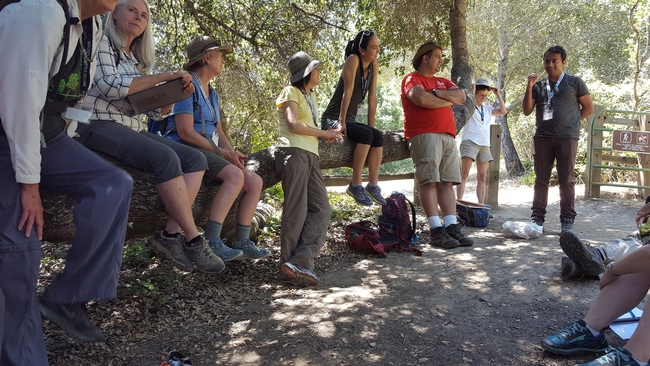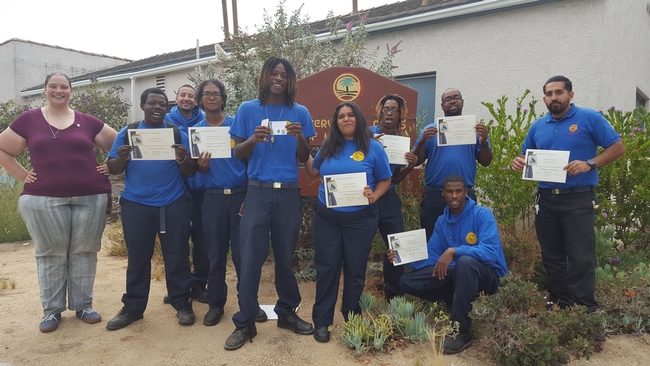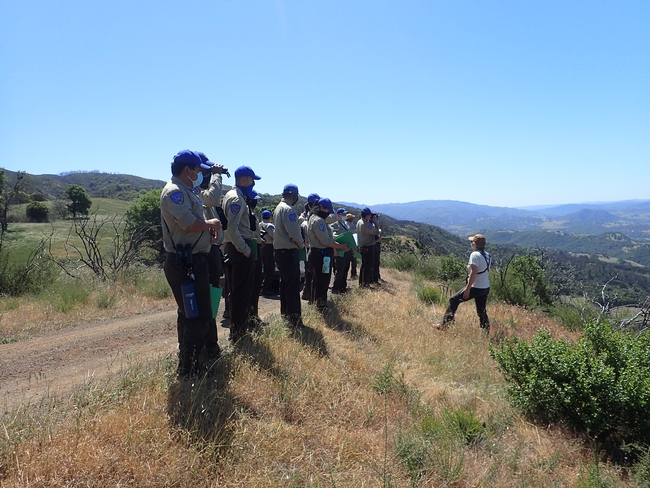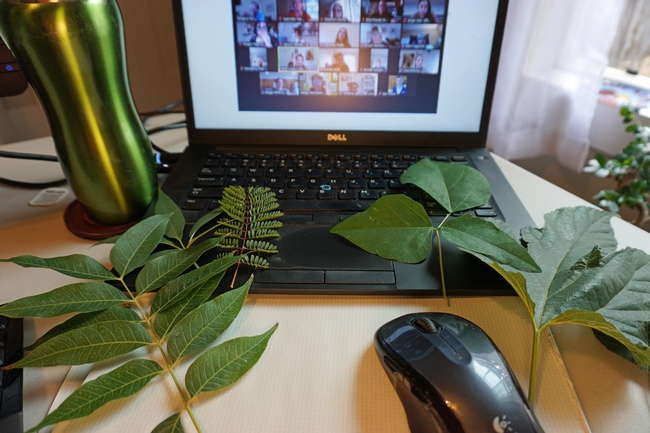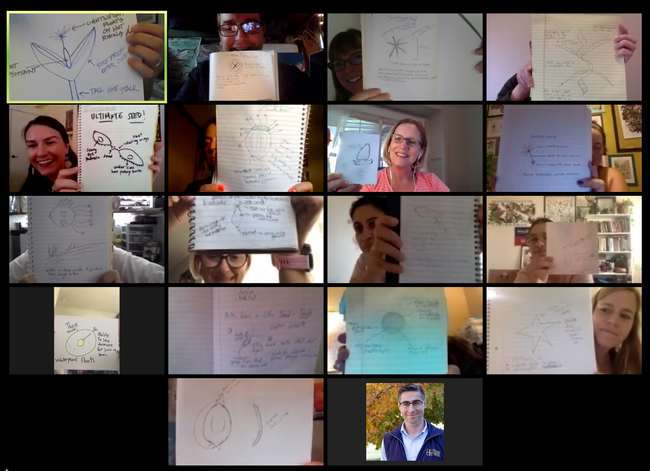
Posts Tagged: UC California Naturalist
UC California Naturalist Conference, Oct. 7–9, highlights environmental challenges, diverse voices
Climate change, extreme drought, intense wildfires and the COVID-19 pandemic can all be linked to humanity's troubled relationship with the natural world.
For more than a decade, healing and deepening connections between people and the environment have been pillars of the UC California Naturalist Program. Partnering with over 80 organizations across the state, the program – a part of University of California Agriculture and Natural Resources – has trained over 6,500 participants and certified more than 5,350 volunteers who engage fellow community members in advancing environmental stewardship and climate resilience.
To celebrate its 10th anniversary, the program is convening a statewide conference Oct. 7–9 along the north shore of Lake Tahoe, under the theme of “Celebrating Community, Nature and Resilience for a Just Future.” Keynote speakers are José González, founder of Latino Outdoors; Rhiana Jones, director of the Washoe Environmental Protection Department; and Obi Kaufmann, artist and eco-philosopher. Members of the public are invited to register for the conference.
UC Naturalists and Climate Stewards (the latter program was established in 2020), as well as instructors for both certification courses, will gather with community members to reflect on their work, share best practices and chart a path toward a more sustainable and equitable future.
“We're striving to create a welcoming and safe space where we can challenge our own long-standing assumptions and perspectives and hear from a wide range of voices on crucial topics, including the latest on climate change and resilience; participatory science; and equity, diversity and inclusion in the conservation space,” said Gregory Ira, director of the UC California Naturalist Program.
Ira also highlighted the conference's equity-based registration fee structure, aimed at minimizing cost as a barrier to participation.
“We encourage anyone with an interest in learning more about California's unique ecosystems – and becoming a better steward of the environment – to join us for the weekend,” he said. “We truly value the perspectives and experiences you can bring to our conference.”
The conference agenda will feature engaging presentations, hands-on workshops and field trips to the area's natural wonders. Presenters include:
- Herman Fillmore, culture/language resources director, Washoe Tribe of Nevada and California
- Don Hankins, Professor, Geography and Planning, Chico State University
- Patricia Maloney, Forest and Conservation Biologist, Tahoe Environmental Research Center, UC Davis
- Adina Merenlender, co-founder of the California Naturalist Program and UC Cooperative Extension professor in conservation science
- Jennifer Norris, deputy secretary for biodiversity and habitat, California Natural Resources Agency
- Ken-ichi Ueda, co-founder and co-director of iNaturalist, UC Berkeley School of Information
For more information and to register, visit the conference website at https://ucanr.edu/sites/2022CalNatCon/.
New wave of California Naturalists emerge from course at Hopland REC
Thirty-eight young, budding naturalists sit in a meadow while journaling and sketching their observations of the wildflowers and birds around them. They have come from various educational backgrounds to gather at the University of California Agriculture and Natural Resources' Hopland Research and Extension Center (REC) to learn about local natural ecosystems through a California Naturalist course.
Although they vary in expertise, these students share a common motivation: immerse themselves in the natural world and eventually teach others about its importance.
“The class really changed the way I view the world around me,” said Will Zuniga, a recent class participant at Hopland REC. “Now that I've taken it, I don't just see plants around me – I see stories. I understand more about the relationship that all of nature's moving parts have with each other. The class has given me more drive to learn about the world around me and to teach others as well.”
Under the UC ANR umbrella, the California Naturalist Program certifies participants through an immersive 40+ hour class delivered by one of its partner organizations, in this case, the California Conservation Corps (CCC). Aged 18 to 25 (and U.S. military veterans up to age 29) and from diverse educational backgrounds across the state, these California Naturalist students worked hard to fulfill the mission of the CCC – to protect and enhance California's natural resources and communities through education and service.
The California Naturalist Program promotes environmental literacy and stewardship through discovery and action. The program is designed to introduce Californians to the wonders of our unique ecology, engage the public in the study and stewardship of California's natural communities, and increase community and ecosystem resilience. Many other states have similar naturalist programs, but this is the first statewide program in California.
“California Naturalist training allows people of different backgrounds to come together to set what is the standard for how we talk about the sky, the ground below us, and the water that's flowing around us,” reflected Jacob Croasdale, a former class participant. “[They teach us] how to engage respectfully in a way that allows us to both receive and give back to nature.”
Although students graduate with broad knowledge of California's natural wonders, prior knowledge of the course's subject matter is unnecessary. “At first, I thought…I don't belong here. I'm just this artist - what do I have to offer?” shared Monique Wales, another former class participant. “There were Master Gardeners, geologists, biologists and people with crazy amounts of knowledge. But we all came together with such enthusiasm, and we wanted to learn from each other. It was such a fun group.”
“People who are thinking about the California Naturalist program but aren't sure that they know enough to step into something where the language is maybe more technical than they're familiar with should not be intimidated,” added Pete Devine, resident naturalist at Yosemite Conservancy. “A lot of participants are beginners and just generally interested folks. These people belong in the California Naturalist Program.”
A quick peek at the syllabus reveals many themes, field trips and interactions with local experts that culminate in the well-rounded knowledge necessary to help preserve our unique ecosystems. California has an incredibly diverse range of wildlife, habitats, rivers, lakes and coastal resources – wild and urban alike – and ecosystem and community resilience are essential.
After the course is completed, California Naturalists perform service through education and interpretation, stewardship, participatory science, environmental program support, community resilience and environmental justice. To date, certified California Naturalists, together with Climate Stewards (another component of the program), have volunteered more than 250,000 hours, worth over $7 million, in 52 of 58 counties in California.
The relationship between CCC and California Naturalist was piloted at the Hopland REC over the last two years and is now being rolled out across the state with support from the Prop 64 Youth Community Access fund. Overall, the project aims to offer three California Naturalist instructor trainings for 48 youth leaders, 24 California Naturalist certification courses for 480 Corps members, visits to or engagement with over 40 unique cultural and natural resources around the state each year, and 3,840 hours of service-learning outreach through youth-led video capstone projects promoting natural and cultural resources.
Overall (and most importantly), the California Naturalist Program allows corps members to have a solid connection to the “why” of their hard work.
Perhaps if we can all connect a bit more with nature in our backyard, we too will see the stories hidden in the plants, water, animals and land.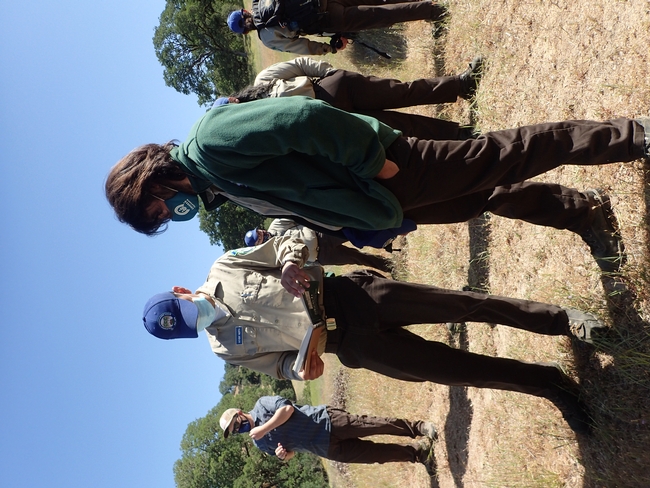
UC inspires a love of nature to ensure future environmentalists
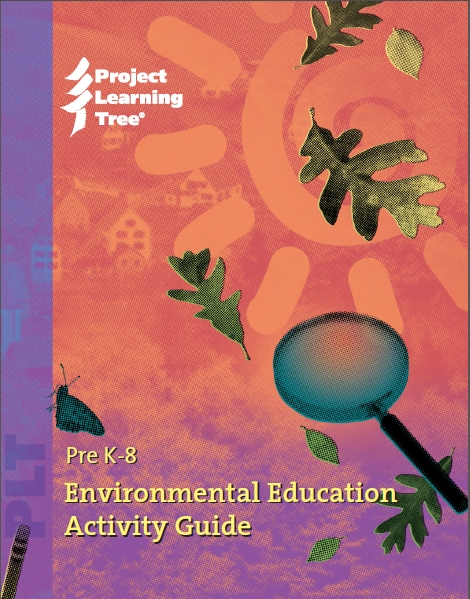
UC ANR provides the California home of Project Learning Tree, a national program founded in 1973, during the height of an environmental movement sparked by Rachel Carson's seminal book Silent Spring.
“Everyone began to realize we were having an impact on the environment,” said Sandra Derby, Project Learning Tree state coordinator.
Project Learning Tree (PLT), working with the forestry industry, developed an environmental education program and trained teachers to present it to children in formal and informal educational settings. In California, the program is funded by CAL FIRE.
Another UC ANR program, UC California Naturalist, has collaborated with PLT since 2013.
“There is a lot of shared interest in environmental education, stewardship and service in our two programs,” said Greg Ira, director of UC California Naturalist (CalNat). The CalNat Program recruits and certifies a diverse community of volunteers across California to conduct nature education and interpretation, stewardship, participatory science and environmental program support.
During the coronavirus pandemic, CalNat offered PLT courses to school teachers, volunteer educators and parents online. Completion of the six-hour course over three days resulted in their certification for teaching PLT curricula. The book, aimed for children pre-kindergarten to eighth grade, includes 96 activities, with objectives, assessment opportunities, online teaching connections, and more.
The teacher training course offered by CalNat engages participants with the same activities they will employ when teaching nature appreciation to children.
Learning to appreciate the environment
Even though online training focuses attention on a computer screen, the PLT curriculum gets pupils outside. After writing about and discussing a favorite tree from memory, the participants were asked to go outside to gather a variety of leaves around their homes, classrooms or offices. They observed leaf details, and sorted them by observable characteristics.
The participants reconvened and shared their leaves, divided into categories onscreen: Leaves with rough edges, rounded, oval or palmate; rough, waxy, furry and thick; drooping down or reaching up.
Teachers can use additional activities outlined in the curriculum to help students understand natural variations and biodiversity by engaging with the leaves through observation and art. For example, if the training is taking place in person, the children can trade leaves and then look for the trees where their peers found them. Or they can put a leaf under a plain piece of paper and rub the side of a crayon across it to show the leaf's margin, veins and other details.
There are also activities related to common core skills and abilities. For example, different leaf characteristics can be charted in a Venn diagram, with leaves' common characteristics appearing in the center – such as green, pliable, veins – and singular characteristics in the sections that do not overlap.
Making environmental learning accessible
PLT advances environmental literacy using trees and forests as windows on the world, said Cynthia Chavez, PLT community education specialist in Southern California. The hands-on, engaging activities help “teach students how to think, not what to think” about the environment and their place within it.
“Environmental education could be taught in a daunting way,” Chavez said. “PLT opens the door to kids who are different kinds of learners. This is important for environmental education.”
PLT's comprehensive collection of activities have won the confidence of the education community. Curricula is only offered to teachers who have completed workshops so PLT can share a proven system of implementation.
“PLT training encourages students to care for the environment and be interested in pursuing careers in environmentalism. They learn science is not just in the classroom. They could become a field biologist, if that's the way their brain works,” Chavez said.
Expressing engagement with nature in words
Among the ways to connect with nature outlined in the PLT curriculum are reading, journaling and writing. To close the educator training, participants were given 10 minutes outside to draw inspiration from nature and write a poem – haiku, free verse, rhyming or other style.
Below are samples of poetic nature observations written on the fly by teachers who will inspire California young people to appreciate and help conserve the natural world with the help of PLT.
Haiku:
A droplet of sun
Planted firmly in soil
Linking earth to sky
Free verse:
I have botany blindness, always looking for things that scurry, not sway
But I am asked to acknowledge the tree, and I do
A lone palo verde
There's a chevron lizard on the trunk
A small, yellow verdin in the branches
A line of busy ants along the roots
So I am grateful for this tree, after all
It sways, and upon closer inspection, it scurries as well
Rhyming:
A fly comes by
As wind hits my hair
Almost as if
It moved here and there
Then Winston, my dog
Hears someone bark
And a bird starts to chirp
Like a crow or a lark
|
Green Jobs Personality Quiz Project Learning Tree offers a one-time free trial intended for adults to test its Green Jobs Quiz. The quiz helps kids learn what green job fits their personalities. You'll receive information about how to administer this quiz to youth you work with. |

